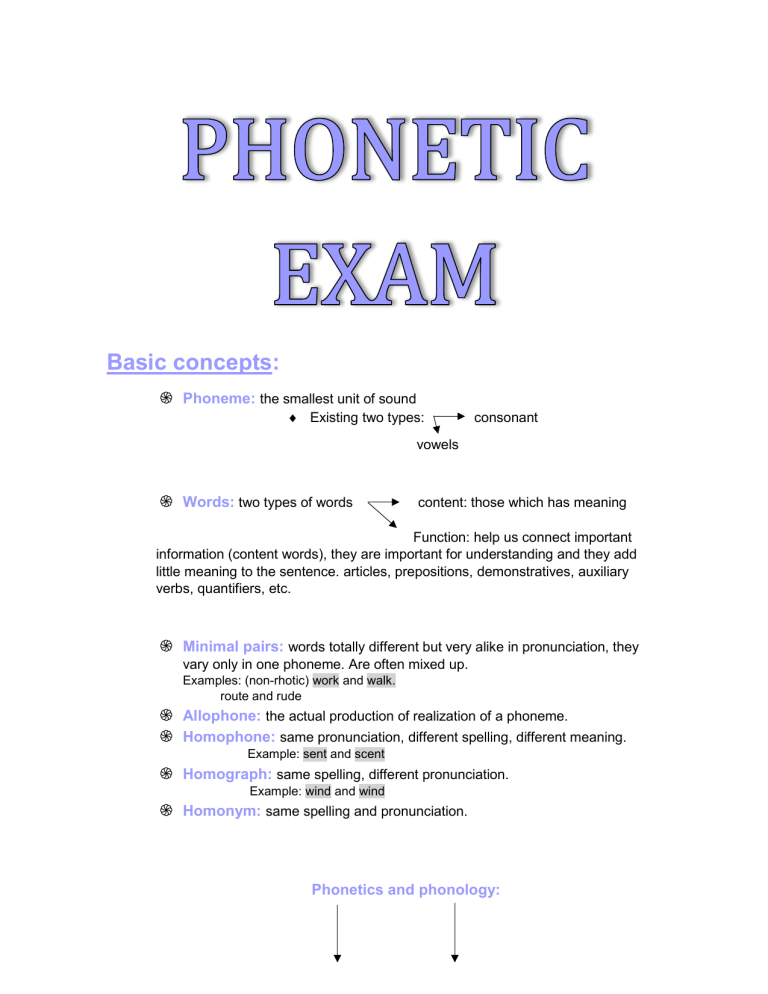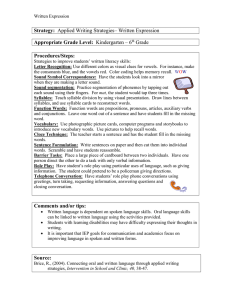
Basic concepts: ֍ Phoneme: the smallest unit of sound Existing two types: consonant vowels ֍ Words: two types of words content: those which has meaning Function: help us connect important information (content words), they are important for understanding and they add little meaning to the sentence. articles, prepositions, demonstratives, auxiliary verbs, quantifiers, etc. ֍ Minimal pairs: words totally different but very alike in pronunciation, they vary only in one phoneme. Are often mixed up. Examples: (non-rhotic) work and walk. route and rude ֍ ֍ Allophone: the actual production of realization of a phoneme. Homophone: same pronunciation, different spelling, different meaning. Example: sent and scent ֍ Homograph: same spelling, different pronunciation. Example: wind and wind ֍ Homonym: same spelling and pronunciation. Phonetics and phonology: How our mouths produce sound. The differences between accents how each language uses the sound. Criteria to decide whether to use the strong form or the weak form of function words: 1. The position of the word within the utterance: ֍ In an exposed position (does not necessarily mean at the end of a sentence) it means that it comes before a pause: strong form. ֍ In a non-exposed position: weak form 2. For contrastive purposes When correcting somebody or removing ambiguity: strong form In all other cases: weak form 3. The function of the word: “That” can function as a demonstrative: strong form. When it functions as a relative pronoun: weak form. When it functions as the main verb (meaning “possession” or obligation): strong form. As an auxiliary verb it will adopt the weak form except when the auxiliary itself is exposed as it does when show in short answers or in question tags; in the latter it will adopt the strong form. 4. When emphasizing an idea: strong form All other cases: weak form. 5. When quoting the function word, the citation form of the word: strong form 6. As a filler, the strong form is used (in hesitant speech) (when you stop to think) Rhoticity: Rhoticity refers to a situation in which English speakers pronounces the rhotic consonant /r/ In rhotic varieties of English, the “r” is pronounced in all cases. Rhotic accent is also called r-full accent, comprises the sound in all possible positions. The r sound is pronounced when is between two voiced vowels. But, for example, when is between one voiced vowel sound and one non voiced, the r sound is not pronounced: “There”. In non-rhotic English, the r sound does not be pronounced when is in an exposed position such as “car”, also is not pronounced when is between a vowel and a consonant. Stress placement: In order to decide on stress placement, is it necessary to make us of some or all the following information: Whether the word is morphologically simple, or whether it is complex as a result either of containing one or more affixes (prefixes or suffixes) or of being a compound word. The grammatical category to which the word belongs (noun, verb, adjective). The number of syllables in the word. The phonological structure of those syllables. Stress in simple words: Two syllables words: Tendency for verbs, adjectives, adverbs, prepositions: 1 2 The second syllable is stressed if it contains: o o o Tendency for nouns A long vowel. A diphthong. Ends with +1 consonant. 1 2 The second syllable is stressed if it does not contain: o A short vowel. Usually, the first syllable is stressed because the 2nd syllable contains a short vowel. Three syllables words: Tendency for verbs 1 2 3 The third syllable is stressed if it contains: o o o A long vowel. A diphthong. Ends with +1 consonant. Tendency for nouns 1 2 3 The third syllable is stressed if it does not contain: o o A short vowel. The diphthong au /ɑʊ/ The second syllable is stressed if it contains: o o o A long vowel. A diphthong. Ends with +1 consonant. Stress in complex words: Affixiated words Words with suffixes. Types of suffixes: Words with prefixes: They are stress neutral prefixes; they will never steal a primary stress. They after carry a secondary stress. Stress attracting Stress neutral Stress shifting Compound words Stress in the first element: Noun+noun Example: ‘Sunrise Stress in the second element: Adjective+participle (ed, ing) Example: bad- ‘tempered. Numerical+adjective Example: three- ‘wheeler. When the word act as an adverb Example: North- ‘East. Adverb+sth acting as an adverb Example: ill- ‘treat. Types of suffixes: ֍ Stress attracting: ESE AIN EE EER ETTE ESQUE IQUE ֍ Stress shifting: Tendency for the primary stress to shift to the penultimate syllable. EOUS GRAPHY IAL IC ION IOUS TY IVE ֍ Stress neutral: ABLE AGE ATE AL EN FUL ING ISH LIKE LESS LY MENT NESS CUS FY WISE ISM Compound words: Compound words are two independent English words that together form a new word. They could be Two complex words. Two simple words. In compound words stress placement can be altered by the position of the object within the utterance: ֍ Predicative position: object+compound stress in the second element: the teacher is bad-tempered. ֍ Attributive position: compound+object stress in the first element: she is a bad-tempered teacher. Sounds that occur in unstressed syllables: ֍ Vowels that occur in us: /ə/ /i/ /u/ ֍ Vowels that tend to occur in us: /ɪ/ /ʊ/ ֍ Possible syllabic consonants which take the place of the /ə/: /l/ /n/ /m/ /r/ /ŋ/ Sounds that occur in stressed syllables ֍ Long vowels: / ɑ: / / ɜ: / / i: / / ɔ: / / u: / ֍ Diphthongs: / eɪ / / aɪ / / əʊ / / aʊ / / ɔɪ / / ɪə / / eə / / ʊə / ֍ Remaining short vowels: /e/ /æ/ /ʌ / /ɒ/ /ɪ/ /ʊ/ Level of stress: primary ‘ secondary , (always goes before the primary stress) Word class pairs: Identically spelt words with prefix but different stress placement ֍ Stress in the according to their first syllable grammatical ‘abstract (A) category ‘contract (V) ֍ Stress in the abs’tract (V) second syllable con’tract (V) Marks goes before the start of a syllable. Intonation: ֍ ֍ ֍ Intonation are patterns of pitch variations along utterances. Tone is the general directions/behaviour of pitch along utterances. There are 5 types of basic tones: 1. Level tone On a steady note, function to convey saying something mechanical. _ yes _no 2. Rising tone Function to convey a wore-to-come answer or a question. yes no 3. Falling tone Function to convey finality and a blunt answer. yes no 4. Rise-fall tone (complex) Function to convey approval, disapproval, or surprise. yes no 5. Fall-rise tone (complex) Function to convey limited agreement w/ reservations. yes no Question tags: with falling tone, I wait for confirmation, I am almost certain with rising tone, I am waiting for your answer, there are 50% chances.




